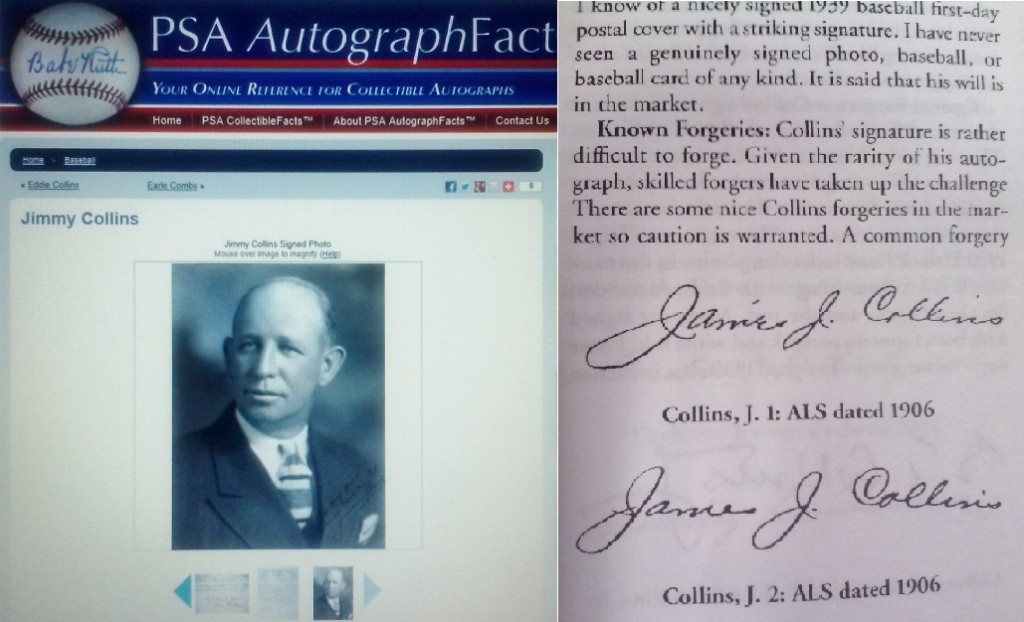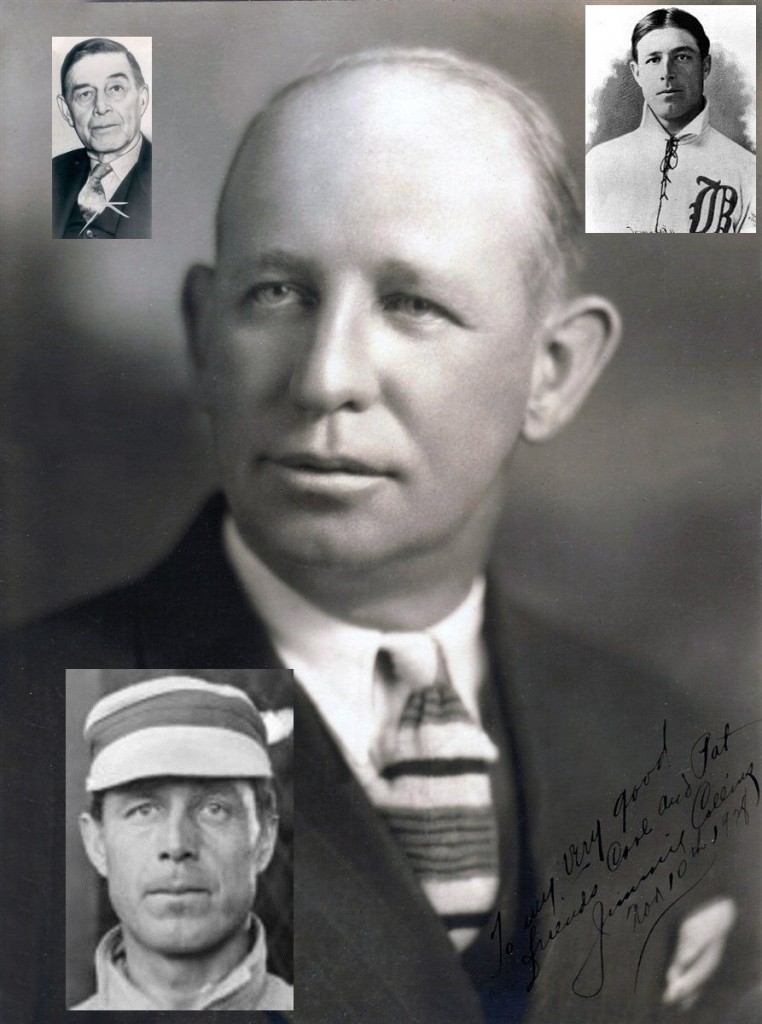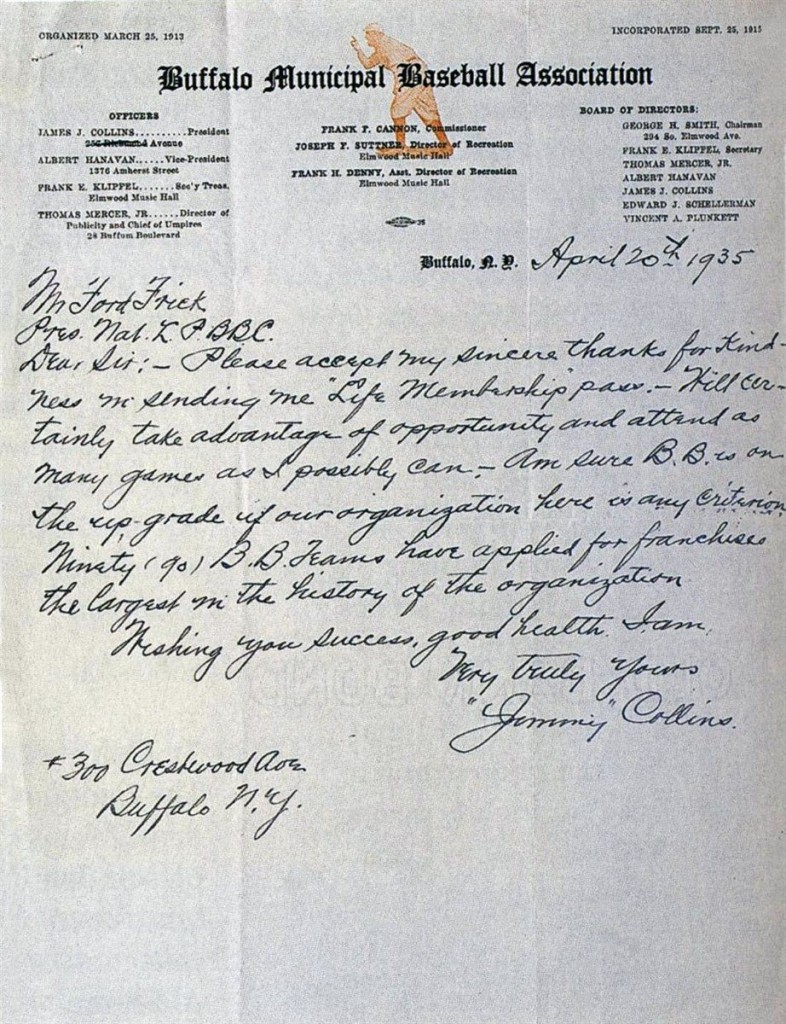March 15, 2013
UPDATE: PSA Fraudsters Appear To Be Sticking With The Fake “Jimmie” Collins (scroll to bottom for update info)
Not too long ago I had a conversation with Richard Johnson, the curator of the New England Sports Museum, and I described for him an interesting talk I once had with James Collins Walsh the grandson of Hall of Famer Jimmy Collins. Walsh told me how he had attended the Irish wake of his grandfather in his old house in Buffalo when he was a young boy. The body of his grandfather, he said, lie on view in an open casket on top of a block of ice and his family and friends celebrated raising pints in honor of the man known as the Boston Red Sox all-time best third-sacker. Collins’ grandson said the event got so festive that a few men actually took Jimmy’s body out of the casket and sat granddad in a chair so he could be among his friends who were telling stories about his glory days at the old Huntington Grounds and drinking from a huge silver loving cup presented to him by “Nuf Ced” McGreevy and the Royal Rooters way back in 1904.
Richard thought the story was remarkable and said something like, “Hey, that would make for a great song.” So, I responded, “Yeah, it could be named ‘The Wake of Jimmy Collins’ by the Dropkick Murphy’s.” It just so happened that Ken Casey of the Dropkick’s is my partner in McGreevy’s 3rd Base Saloon, in Boston, a faithful reincarnation of the turn-of-the-century watering hole that was, in part, nicknamed in honor of Collins, Boston’s most beloved ballplayer of the dead-ball era. I told Richard if he wrote the song I’d pass it along to Ken and see what he thought. Ken and the band had already successfully revitalized the Red Sox fight song “Tessie” in 2004, so I thought it had a shot considering also that the most prominent photograph on the walls of the 3rd Base Saloon (both then and now) is a mammoth portrait of Jimmy Collins.
Months later Richard and I participated in a John F. Kennedy Library Forum along with Ken celebrating the 100th anniversary of Fenway Park and soon after I got an email from Richard with the lyrics for the song. I passed them along to Ken and sure enough the lyrics struck a cord.
Richard’s lyrics gave the Sox skipper “one last toast” and made the cut when Ken unveiled the final product on the band’s new album Signed and Sealed in Blood with the introduction of the song, “Jimmy Collins’ Wake,” a number that evokes visions of T206 baseball cards and incorporates the names of old-timers like “Patsy” Dougherty, “Buck” Freeman, “Chicken Jack” O’Brien and Honus Wagner. After hearing the song for the first time I laughed and reminded them both that the inspiration for the song was the singular reminiscence of the man who actually knew Jimmy and attended his wake–his grandson. A fitting tribute for sure.
Not too long after I heard Ken perform the song at McGreevy’s, I was checking out the PSA website and its “Autograph Facts” section which had recently added some new exemplars of Hall of Famer signatures, including the man Boston fans called the “People’s Choice.” I had just recently provided some exemplars of Collins’ authentic signature to author Ron Keurajian for use in his new autograph handbook, so I was curious to see what exemplars PSA was using.

The current PSA "Autograph Facts" page features this alleged inscribed photo by Jimmy Collins (left). Ron Keurajian's autograph hand book includes several authentic exemplars from c.1906 (right) (McFarland)
One was an excerpt from an authentic letter. The second was a note said to have been written by Collins and the third was a 1928 portrait allegedly signed and inscribed by Collins to two friends. But there was a big problem with this photo since the man in the depicted didn’t look like anything like Jimmy Collins. How could this be? Were my eyes deceiving me? Not at all, I could easily ascertain this was not Jimmy Collins. The ears were too big, the nose too round and the hairline was off. How could PSA have authenticated this one?
I figured I should also seek out the opinion of the man who penned the lyrics for “The Wake of Jimmy Collins.” Richard Johnson is also the co-author of Red Sox Century, the definitive history of the Red Sox franchise, and quite familiar with all of the existing dead-ball images that feature the likeness of Jimmy Collins. When I showed the photograph to Richard, he responded:

The alleged signed Jimmy Collins photo authenticated and appearing on the PSA "Autograph Facts" section is flanked by actual portraits of Collins ranging from 1903 to the 1940s. The facial structure of Collins is nothing like the man in the alleged autographed Collins photo.
Could the man who gazed into the face of his deceased granddad at that Irish wake when he was a kid offer an opinion? I sent the photo to James Walsh but hadn’t heard back from him by the time this article was published. I’m betting his response will be the final nail in PSAs coffin.
Beyond the photo itself, even more troubling is the fact that the handwriting doesn’t resemble that of Jimmy Collins from that era either. PSA had an authentic letter written by Collins available for comparison and still erred miserably. The letter posted as an exemplar for Collins was a 1935 thank you note to Ford Frick for sending him a lifetime pass for National League games.

PSA utilizes this authentic Jimmy Collins letter as an exemplar of the HOFer's handwriting on its "Autograph Facts" section of its website. The document is believed to have been stolen from the NBL and the donated Ford Frick Papers..
We know this letter is undoubtedly authentic for it is believed to have been stolen from the National Baseball Library’s Ford Frick Papers which include hundreds of such thank you letters for season passes. The thefts of the Frick letters were covered in a recent article we published stating that Cooperstown may have lost close to $500,000 in documents wrongfully removed from the Frick holdings housed in the library.
If anything, the alleged 1928 signed photograph incorporates handwriting that is more similar to Collins’ handwriting several decades earlier, as evidenced on authentic letters from the turn of the century. Still, although there are slight similarities, the writing on the photograph is not in the hand of Jimmy Collins. Not only does it not resemble Collins’ handwriting, the PSA exemplar is clearly misspelled “Jimmie” when the Red Sox star usually signed his name “Jimmy.”
Despite these fatal flaws, however, PSA didn’t realize that the subject in the alleged Collins photograph was not Hall of Famer Jimmy Collins.
That being said, PSA and JSA actually got one right on a recent Collins offering at Huggins & Scott Auctions. The Jimmy Collins 3×5 card they certified as authentic actually is. So, why can’t they tell that the photograph (which doesn’t even depict Collins) bears a forgery or a signature of another guy named “Jimmie”? Steve Grad and PSA haven’t had much luck when it comes to the spellings of Irish ballplayers as evidenced by Grad’s infamous Big Ed Delahanty blunder.
Advertised as PSA’s lead expert, Steve Grad was a MastroNet employee before he started working for the authentication giant and recently was said have secured a spot as the sports expert on the hit cable-TV show Pawn Stars on the History Channel. Despite his resume, Grad’s questionable skills as an authenticator have been thoroughly exposed by our recent reports illustrating numerous forged and non-genuine items that he and his company have certified as authentic.
Grad has recently authenticated high-profile forgeries and non-genuine secretarial signatures of players ranging from Mickey Welch to Lou Gehrig and is responsible for some of the most astounding blunders in authentication history including the certification of a full secretarial letter falsely attributed to Hall of Famer Ed Delahanty that was also misspelled ”D-e-l-e-h-a-n-t-y.” That worthless letter was sold by Hunt Auctions for over $30,000 based upon Grad’s LOA and an additional letter from his old colleague James Spence of JSA. Grad and PSA have also certified as authentic a laser-copy signature of Ty Cobb and another alleged Cobb scrawl signed on a ball manufactured after the “Georgia Peach’s” death. He even certified as authentic a well known 1990s Babe Ruth forgery for Heritage Auctions who tried to unload it for $110,000. Grad’s recent mistakes on bogus signatures of Candy Cumming’s, Mickey Welch and the Jimmy Collins photo featured in this report have become a common occurrence for the company that claims to have authenticated over 20 million collectibles since the company’s inception.

PSA/DNA's lead authenticator, Steve Grad (far left) got his start with indicted hobby kingpin Bill Mastro (left) and is now the preferred expert linked to eBay offerings. He'll also be on Pawn Stars as an expert next season. If Rick and the boys were looking for some controversy and a link to hobby indictments and guilty pleas, they found it.
We consulted with autograph expert Ron Keurajian in regard to the Collins signatures and he referred us to his book, Baseball Hall of Fame Autographs: A Reference Guide and his study of Collins’ signature. In regard to Collins signed photographs, Keurajian says he has “never seen a genuinely signed photo” and although he says the Huggins & Scott 3×5 of Collins is genuine he states in his book that other album pages and index cards feature forgeries “signed as either ‘James J. Collins’ or ‘Jimmy Collins’ and the phrase ‘Third Sacker’ is penned underneath the signature.” To show what lengths some people will go to get a signature of the Red Sox legend, Keurajian says “his will is in the market” referring to Collins’ last will and testament that was stolen from a Buffalo, NY, courthouse in the 1990s and is still missing, buried in some collectors treasure-trove.
With the luck of the Irish it just might make its way back someday. With a little more luck, the owner of the bogus “Jimmie Collins” photo with a PSA LOA might get a refund.
A Happy St. Patrick’s Day Weekend to all of our readers!
(UPDATE Fri. March 22nd): PSA Fraudsters Appear To Be Sticking With Their Fake “Jimmie” Collins on “Autograph Facts”
Its been a week since we released our story exposing PSA/DNA’s flawed authentication of the alleged “Jimmie” Collins autographed (and misspelled) photo that does not even feature the likeness of the real Hall of Famer, “Jimmy” Collins. As reported by Haulsofshame.com, PSA included the photograph on its website as part of a trademarked section it describes as:
PSA AutographFacts™ is the ultimate online resource for the most coveted signatures from the world of sports, history and entertainment. From legendary baseball players to U.S. Presidents to music icons, each signor is profiled in detail. Unlike most other manufactured collectibles, autographs connect the collector with the subject as a result of the personal touch.
In our last report, we exposed two other glaring mis-authentications of 19th century rarities falsely attributed to Hall of Famers Smilin’ Mickey Welch and Candy Cummings. The alleged Welch autograph (which would have been worth upwards of $50,000) was only a period identification on a cabinet card that had been stolen from the New York Public Library and the Cummings was a period secretarial notation simply identifying Cummings as well. After we released our report, PSA removed rather quickly the embarrassing inclusions from the Autograph Facts database. Not so with the current fraudulent “Jimmie” Collins photograph.
PSA has chosen to keep the embarrassing entry in its online database, thus misrepresenting to its customers, and collectors at large, what a Jimmy Collins signed photograph should look like. It is simply a signed photo of someone who is not Jimmy Collins, another person who just happened to be named “Jimmie” Collins and shared some very slight similarities in his handwriting with the Hall of Famer.
PSA states that a signed Jimmy Collins photograph is worth only $7,500, however, several industry experts we spoke with estimated that genuine examples would command well over $25,000 if authentic. We can only speculate as to what price was paid by the collector who currently owns the fake Collins photo. We can also only speculate as to whether the seller of the photograph had close ties to PSA/DNA and its authenticators. Several collectors we spoke with allege that PSA/DNA has engaged in what can only be viewed as racketeering and showing favoritism to preferred clients and agents by knowingly authenticating non-genuine items and thus transforming worthless items into extremely valuable treasures simply for the fact that they are accompanied by a fraudulent PSA/DNA letter of authenticity or opinion. If this is the case with this particular alleged Collins photograph it will serve as another piece of evidence against the authentication giant that has already come under close scrutiny by Federal investigators for its role in authenticating and grading the trimmed T206 Honus Wagner card that has played a significant role in the indictment of ex-hobby kingpin, Bill Mastro. If the Wagner card represents the worst of PSA in regards to card grading, the “Jimmie” Collins photo is its equivalent in relation to autographed items (but at least the Wagner card, itself, is real).
The public exposure of this fraud by Haulsofshame.com and the choice that PSA/DNA has made in continuing to fraudulently include it among authentic exemplars, should give collectors great concern in regard to their own items which are accompanied by PSA LOA’s.
Stay tuned for our next report Monday which will expose yet another alleged PSA fraud.


